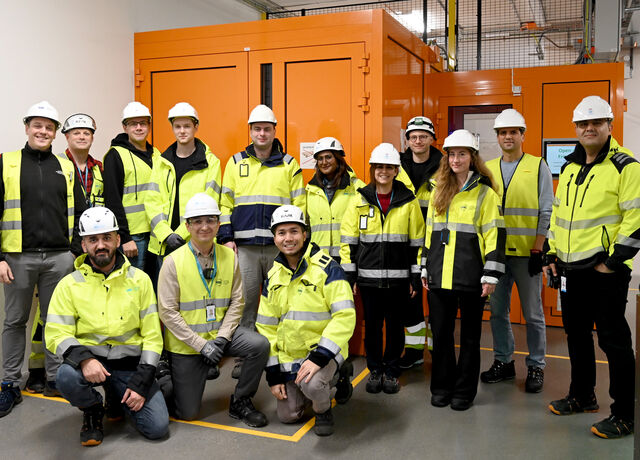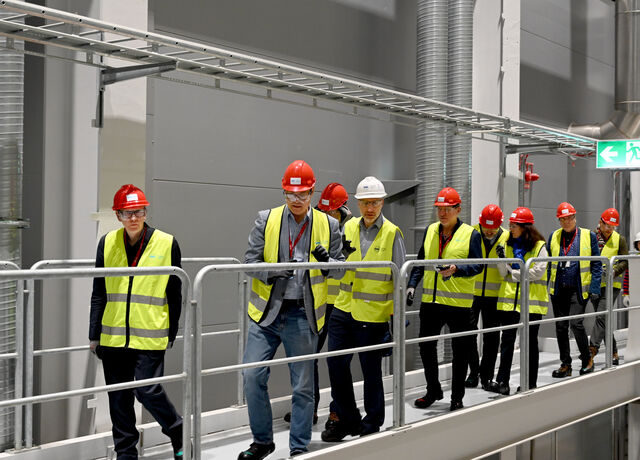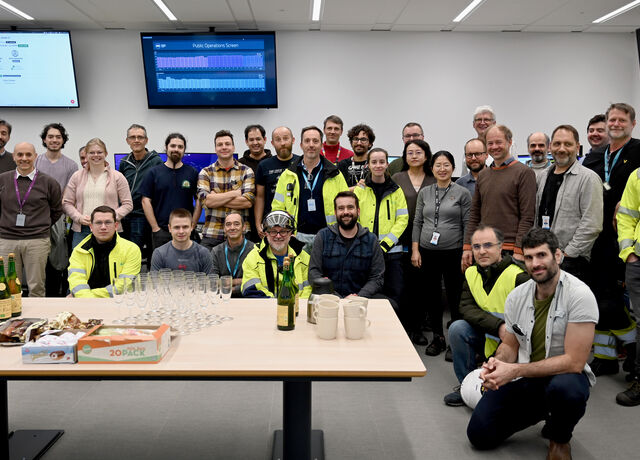Particle Physics
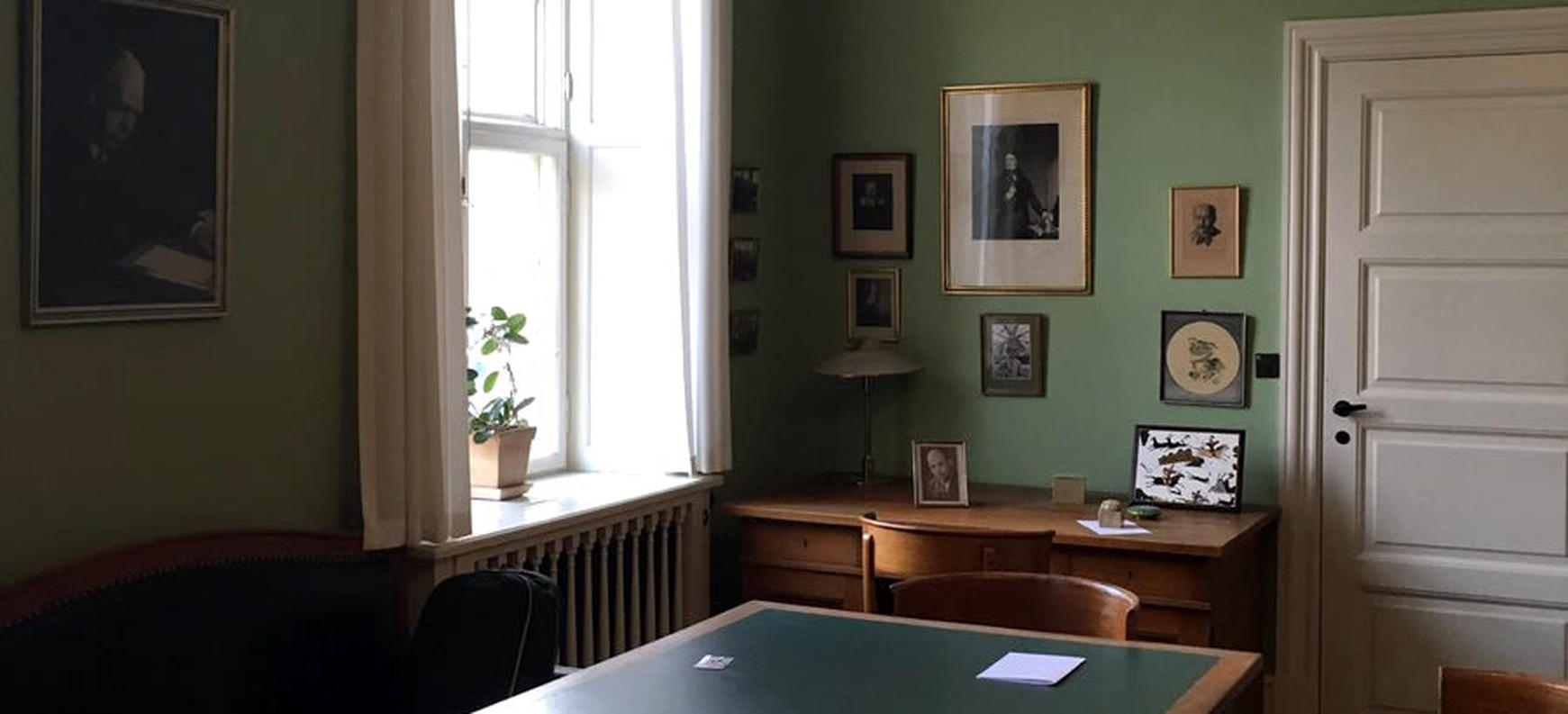
Niels Bohr's former office in Copenhagen (J. Womersley)
For the last five decades, the Standard Model of particle physics has successfully provided our framework for explaining phenomena involving three of the four known forces of nature. However, there are many reasons to believe that the Standard Model is not the complete theory.
Besides the energy frontier, there exists another frontier in the search for what is called the new Standard Model: the high precision, high sensitivity frontier. The pattern of deviations (or their absence) that emerges from precision experiments is like a set of footprints of new forces.
The higher intensity and the pulse structure of ESS provide new possibilities for fundamental neutron physics experiments, and it will be possible to investigate a wide range of fundamental phenomena with superior sensitivity to previous experiments. Click here to download the Technical University of Munich's report on fundamental physics at ESS.
Four potential instruments for particle and nuclear physics at ESS have been identified:
ANNI is a cold neutron beam facility for particle physics, it will make full use of the ESS pulse structure.
User experiments which used pulsed beams at continuous sources will gain between one and two order of magnitude in the event rate. Since the time structure of the neutron beam enables powerful techniques to suppress systematic effects.
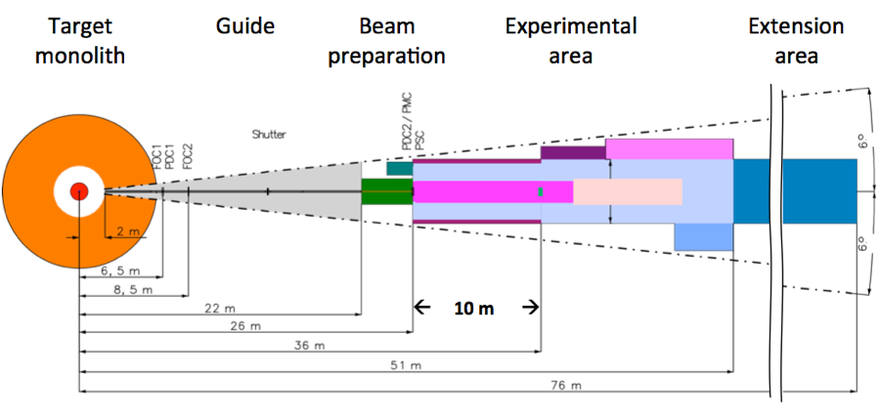
The proposed instrument is optimised for measurements of correlation coefficients in neutron beta decay. It will improve the measurement by one order of magnitude, unlocking the accuracy range of 10-4 and providing broad band probes for physics beyond the standard model.
The achievable accuracy tests new physics on a mass scale of 1-100 TeV, this mass scale is far beyond the threshold for direct production at existing or planned particle colliders.
Weak interaction between quarks in the strangeness-conserving sector is difficult to access experimentally, because of the overwhelming strong interaction. Hadronic parity violation is traditionally parametrised by the meson exchange model of Desplanques, Donoghue, and Holstein (DDH) [1]. DDH have estimated these weak parameters using quark models and symmetry arguments and quoted reasonable ranges and best values, because of strong interaction uncertainties (called “best guesses” in [2]). Since a few years, this situation is changing qualitatively: Effective field theories allow model-independent parametrisations [3]. Progress in models gives new values for the parameters [4]. In particular, QCD on the lattice starts to be able to calculate parameters of the effective theories from fundamental QCD and weak interaction [5].
New lattice gauge theory collaborations have been formed to calculate challenging non-perturbative QCD observables, such as nucleon-nucleon weak amplitudes and beta decay form factors. The latter are relevant for interpreting precision measurements in neutron beta decay, see previous section. These theoretical developments enable quantitative tests of the non-perturbative limit of QCD, provided that experiments become sufficiently sensitive. A better understanding of hadronic weak interaction and precise measurements of its parameters are also needed as input to nuclear theory.
Electromagnetic properties of the neutron are related to diverse open questions of particle physics, see [6] for a review. The electrical neutrality of neutrons and of atoms is not required by the SM. The experimental limits of the order of 10-21e can be considered as experimental hint for grand unification. Electric dipole moments (EDMs), search for charge conjugation-parity violation (CP violation) beyond the SM, at scales LBSM of 1 TeV to more than 1000 TeV are motivated by the question of the origin of the matter-antimatter asymmetry in the Universe. Creating this asymmetry requires a process that violates the symmetries baryon number B, charge conjugation C, and CP, and that takes place out of thermal equilibrium [7]. Although the SM contains all necessary ingredients, it is not able to explain the observed asymmetry, see [6] for a recent review.
EDMs are very sensitive probes for CP-violating physics beyond the SM: The values caused by the CP violation of the SM (dn≈10-32ecm for the neutron)) are many orders of magnitude below the present experimental limits (dn<2.910-26 ecm (90% CL) for the neutron), whereas theories beyond the SM in general include new possibilities for CP violation and thus allow for larger EDMs.
In the past, the neutron EDM has ruled out more such theories than any other observable or limited their parameter space substantially. For a large class of grand unified theories a cosmological lower bound for the neutron EDM of dn ≥ 310-28 ecm has been derived in [8] which gives a benchmark for future experimental searches. If a neutron EDM is found above 10-28 ecm, it would be a strong hint for baryogenesis near the electroweak scale; if not, other ways such as leptogenesis or processes close to the inflationary scale are more probable. The detection of EDMs or improved limits in different systems (neutrons, atoms, molecules) provide more information on the underlying physics and an increased sensitivity .
[1] B. Desblanques, J. F. Donoghue, B.R. Holstein, Ann. Phys. (NY) 124 (1980) 449.
[2] W.C. Haxton and B.R. Holstein, Prog. Part. Nucl. Phys. 71 (2013) 185.
[3] S.-L. Zhu et al., Nucl. Phys. A 748 (2005) 435.
[4] H.-J. Lee et al., Phys. Lett. B 713 (2012) 439.
[5] J. Wasem, Phys. Rev. C 85 (2012) 022501(R).
[6] D. Dubbers and M.G Schmidt, Rev. Mod. Phys. 83 (2011) 1111.
[7] A.D. Sakharov, JETP Lett. 5 (1967) 32.
[8] J. Ellis et al., Phys. Lett. B 99 (1981) 101.
The basic elements of the instrument are the neutron guide, the chopper system, the area for the beam definition, the experimental area and the elements needed to fulfill the requirement of the beam line.
A sketch of the instrument is shown in Figure 1 and in Table1 are shown the description of the instrument’s basic element.
ELEMENT |
DISTANCE [M] |
LENGTH [M] |
WIDTH |
|---|---|---|---|
|
NEUTRON GUIDE |
2 |
20 |
|
|
AREA FOR BEAM DEFINITION |
22 |
4 |
|
|
LAST CHOPPER |
26 |
|
|
|
STANDARD AREA FOR USER EXPERIMENTS |
26 |
25 |
11° |
|
EXTENDED AREA FOR USER EXPERIMENTS |
51 |
25 |
5 m |
Table 1. Positions (given as distance between moderator and start of the element) and sizes of the instrument’s basic elements.
Ultra-cold neutrons (UCN) play an important role to address key questions of particle physics at the low-energy, high-precision frontier, complementary to experiments done at high-energy particle accelerators.
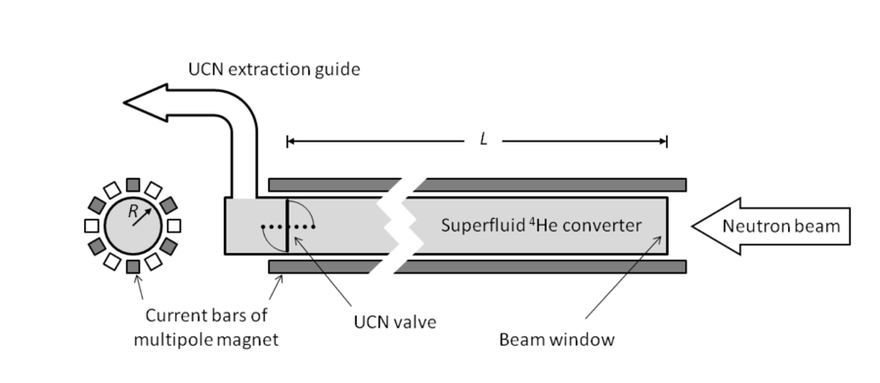
UCN are an excellent tool for precise measurements. Experiments using UCN provide values of observables important for applications ranging from particle physics to cosmology. The UCN source proposed at ESS is a superfluid helium target at the end of a cold neutron beam. The neutron beam should be extracted from the cold moderator with a large solid angle in order to maximize the flux, possibly similar to the NNBar extraction.
Visible projects employing UCN are the search for a neutron electric dipole moment (EDM) and the investigation of quantum states of the neutron using gravity spectroscopy. The neutron EDM investigates violation of the fundamental CP-symmetry and the baryon asymmetry of the Universe, whereas gravity resonance spectroscopy (GRS) addresses gravitation at short distances in the micrometre range in order to probe scenarios of extra-dimensions that might explain why gravitation is so much weaker than for instance the electrostatic force between two charged bodies. These experiments have huge potential for improvement at the ESS. They require an experimental area with excellent magnetic shielding and low vibration conditions.
Further examples of projects using UCN with strong potential for improvement at the ESS are the neutron lifetime, which impacts the abundances of light chemical elements in big-bang nucleosynthesis, clock comparison experiments addressing questions of Lorentz invariance, dark matter and quantum-mechanical effects that can be excellently studied in optics with very slow neutrons.
Best current UCN sources deliver densities of the order of only a few tens per cm3, so that many fundamental physics projects are statistically limited. Key goals of the UCN source proposed for the ESS are a UCN density exceeding 104 per cm3 and provision of experimental conditions necessary for the flagship experiments in order to push down systematic effects accordingly.
The UCN source proposed at ESS takes advantage of ten years of development work of superfluid-helium UCN sources started at FRM2 and continued at the ILL. In addition, with ILL’s Endurance project SuperSUN (Figure) it will have an important precursor, for which a UCN density of 103 per cm3 has been projected. With one order of magnitude higher UCN density, the ESS source will provide to the community a valuable new tool with strong impact.
UCN production is based on the well-established conversion of cold to ultracold neutrons via inelastic scattering in superfluid helium. A magnetic multi-pole reflector drastically enhances the UCN density with respect to the prototype superfluid-helium UCN source installed in a cold neutron beam at ILL. The reflector repels low field seeking UCN and thus strongly reduces losses due to UCN collisions with the material walls of the converter. A special feature is an intrinsic high UCN polarization provided due to spin dependent trapping by the multi-pole magnet, which is very welcome for the flagship experiments but also for projects employing external magnetic traps.
A sensitive search for neutron-antineutron oscillations can provide a unique probe of some of the central questions in particle physics and cosmology [10]: the energy scale and mechanism for baryon number violation, the origin of the baryon-antibaryon asymmetry of the universe (with implications for static electric dipole moments), and the mechanism for neutrino mass generation.
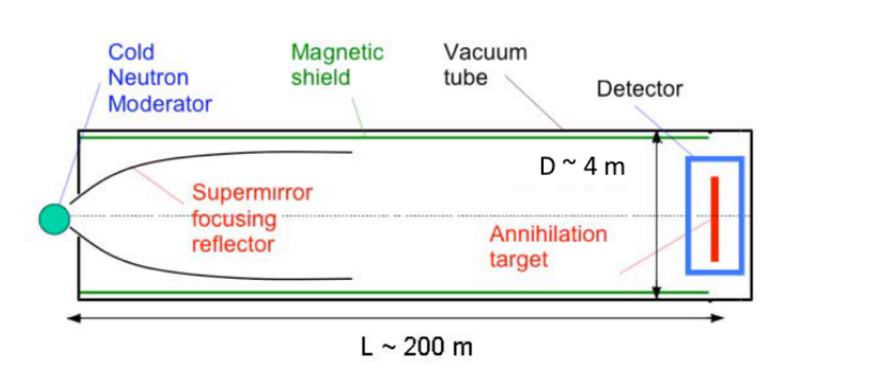
If a signal would be observed it would be a major discovery, of similar impact and importance to the oscillations found for other neutral particles, e.g. in the kaon system (CP violation, Nobelprize 1980) and for neutrinos (Nobelprize 2015). A remarkable opportunity has emerged to search for neutron-antineutron (n→n) oscillations with the construction of the European Spallation Source (ESS) in Lund. The international NNBAR collaboration has thus been established. The collaboration aims to undertake a search for n→n oscillations which would benefit from a sensitivity to the n→n probability which is three orders of magnitude greater than obtained at previous experiments [11, 12].
The decay of a proton (or of a neutron that is otherwise stably bound in a nucleus) is an obvious candidate for baryon number violation studies, violating baryon number by 1 unit, ΔB = 1, and current limits probe very high energy scales (~1015 – 1016 GeV). Neutron-antineutron oscillations, on the other hand, violate baryon number by 2 units, and can take place even if proton decay is absent.
They can be induced by new physics at energy scales as low as a few TeV. In fact, some models which predict n→n oscillations also predict measurable signatures (due to "colored scalars") within reach of the Large Hadron Collider. Neutron-antineutron oscillations provide an experimentally accessible window on a variety of sources of new physics at moderate energy scales, such as theories with extra spatial dimensions and viable models for baryogenesis at or below the electroweak symmetry breaking scale. The ΔB=2 selection rule relates n→n oscillations to Majorana neutrino mass generation in models which unify quarks and leptons, providing another window on the origin of neutrino mass.
Given the connections to these essential questions, the unambiguous detection of n→n oscillations would have enormous impact on the course of particle physics, not only motivating improvements in the detection sensitivity, but establishing new physics at accessible energy scales. Experiments designed to detect n→n oscillations fall into two categories: large volume, low background underground experiments and experiments with cold neutrons. In both cases, the experimental signature that an oscillation has taken place is striking: the annihilation of the antineutron, releasing roughly 2 GeV of energy, typically in the form of pions (4 to 5 pions on average). At present, the best limits on n→n oscillations come from water Cerenkov detectors (SuperKamiokande) [12] , where limits are derived from oscillations for neutrons bound in oxygen nuclei. These experiments, however, are already limited by an irreducible background from atmospheric neutrinos, making large increments in sensitivity prohibitively difficult. Experiments with cold neutron beams do not suffer from this limitation, in that the oscillation amplitude develops "in-flight" as a cold neutron beam propagates freely from a focusing optic to an annihilation target. The target is surrounded by a detector capable of accurately reconstructing the annihilation vertex position and release energy, providing essentially background free detection of the annihilation signature. The most sensitive cold neutron experiment to date was performed at ILL in 1990[11] , and is about three times less sensitive to antineutron annihilations than the SuperKamiokande experiment. With the advances in neutronics technology over the last 25 years, a new cold neutron experiment can now be performed with a very large increase in sensitivity.
The envisioned nnbar experiment at ESS will have a goal to have at least a factor of 1000 greater sensitivity to the oscillation probability than the ILL experiment (after 3 years of operation). The critical technologies (advanced neutron optics and high resolution trackers and calorimeters) already exist, and the ongoing work towards a technical proposal is focused on a cost-effective optimization of the experiment.
A next-generation experiment at ESS would use a similar configuration as used at ILL, but exploiting progress in both neutronics and detector technologies to push the experiment’s sensitivity to the oscillation probability by approximately three orders of magnitude. The figure of merit (or sensitivity) for a free n→n search experiment is Nnt2, where Nn is the free neutron flux reaching the annihilation target and t is the neutron observation time.
The specific sensitivity (figure of merit) reveals the need for maximization of three characteristics of the ESS experiment/target interface.
- A moderator that delivers the highest possible intensity of cold neutrons (energy < 5meV, or velocity < 1000 m/s, or wavelength > 4Å) is important towards improving both Nn and t. The overall intensity is the product of brightness and moderator area, so that maximizing the product of the two is beneficial.
- A large beam port allowing the largest possible solid angle view of the cold moderator surface area will ensure that a maximal fraction of the flux will be accessible to the initial reflector geometry, thus enhancing transport to the annihilation target.
- An overall lower neutron spectrum emission temperature is desirable from the standpoint of enhancing the transport efficiency of the m=6 super-mirror reflector. This would also boost the sensitivity significantly by increasing the mean transit time. Higher m technology is under development by the collaboration to further enhance the experiment’s sensitivity.
A schematic view of the experiment layout is shown above.
[10] D.G. Phillips II et al. , Phys. Rept. 612 (2016), 1-45
[11] M. Baldo-Ceolin et al. , Z.Phys. C63 (1994) (409)
[12] K. Abe et al. , Phys. Rev. D91 (2015) (072006)
HI-BEAM (High-Intensity Baryon Extraction and Measurement) is a recently proposed instrument at ESS.
This project has its own physics program but is also foreseen as a prototype for the NNBAR experiment.
Its scientific program includes search for mirror neutrons, measurements of weak nucleaon-nucleaon interactions and search for n-n oscillation by a factor 2-10 compared to previous ILL searches.
Status of the Instruments
- Today, all three instruments and HIBEAM are pushed by specific consortia.
- For ANNI, a design is available and a full ESS instrument proposal was submitted jointly by scientists from different universities and labs.
- For UCN Source and NNBAR detailed designs are not yet finalised, but letters of intent (LoI) with preliminary gain factors were submitted.
- A Scientific and Technical Advisory Panel (STAP) for fundamental physics has been established to advise and later to review the instrument proposals and letters of intent.
Fundamental & Particle Physics Science Drivers
A selection of possible topics in which the ESS gain factor over current facilities will be significant are outlined below. More thorough, complete reviews are available.
The search for the neutron electric dipole moment is already shedding light on one of the outstanding puzzles at the interface of particle and nuclear physics with cosmology: Why is there more visible matter than antimatter in the universe? The observation of a non-zero electric dipole moment of the neutron could signal the presence of CP- violating interactions needed to produce the early universe charge asymmetries. CP violation is a violation of the postulated CP-symmetry: the combination of C-symmetry (charge conjugation symmetry) and P-symmetry (parity symmetry). CP-symmetry states that the laws of physics should be the same if a particle were interchanged with its antiparticle (C symmetry), and then left and right were swapped (P symmetry).
To date, there are only upper limits on the magnitude of the neutron electric dipole moment and on the electric dipole moments of other systems, such as neutral atoms from which one deduces an upper limit on the electron electric dipole moment. Since it is not known where the CP-violation needed for the abundance of matter might live, it is important to search for electric dipole moments of a variety of systems. Consequently, one should view the neutron electric dipole moment program in the broader context of electric dipole moment searches.
The current neutron electric dipole moment limit is, nevertheless, compatible with predictions of supersymmetry, in particular ``supersymmetric electroweak baryogenesis'' under the right conditions for the superpartner spectrum. It would likely take future electric dipole moment searches with two orders of magnitude better sensitivity to conclusively test this possibility. Experiments underway at the ILL in Grenoble, PSI in Switzerland, and Spallation Neutron Source in the U.S. are working their way toward this horizon. It may be that a future experiment at ESS, with the significantly higher neutron flux, could push the neutron electric dipole moment program across the finish line in the search for cosmologically relevant CP-violation.
The neutron decay physics programme is rich and includes the following precision tests of the Standard Model and search for physics beyond the Standard Model. In contrast to the electric dipole moment experiments, precise studies of neutron decay parameters, such as the neutron lifetime and decay correlation coefficients, start off by measuring quantities that are not suppressed in the Standard Model. In this case, the goal is to look for exquisitely small deviations from the non-zero Standard Model predictions that could signal the presence of virtual new particles that were more active as real particles in the early universe.
There is an interplay between the level of experimental uncertainty and the ability to make precise predictions from the standard model. To illustrate, consider tests of the unitarity of the Cabibbo-Kobayashi-Maskawa (CKM) matrix or ``quark mixing matrix'', for which superallowed nuclear ß-decay provides the most input in the guise of Vud. Vud is one of the elements of the CKM matrix, which is related to the probability that a down quark decays into an up quark via the weak interaction. Combining the results of an extensive program of experimental lifetime, branching ratio, and Q-value measurements with recent progress in computing hadronic contributions to Standard Model electroweak radiative corrections, one obtains a value for Vud with a precision of a few times 104. Looking to the future, if progress is made in reducing the uncertainties associated with Vud, the limit in CKM unitarity tests may again be set by Vud. In this respect, a program of neutron decay studies that include a more precise determination of the lifetime and one or more of the decay correlation coefficients, may provide a path forward. The nuclear decay determinations of Vud are likely to hit an irreducible uncertainty associated with nuclear structure corrections to the fit values. In addition, certain neutron decay correlations may provide information about new interactions that do not have pure left- or right-handed character or exotic particles such as leptoquarks.
An observation of neutron-antineutron oscillations would constitute a discovery of fundamental importance for particle physics and cosmology. The required change in baryon number by 2 units with no change in lepton number would signal physics beyond the Standard Model, and could be relevant for understanding the matter-antimatter asymmetry of the universe. There have been recent developments in cold neutron technology which may make possible improvements in the sensitivity to the free neutron oscillation probability by factors of 100-1000. For these sensitivities a null result would place the most stringent limit on this possible mode of matter instability. At an intense pulsed source such as ESS, one can imagine reducing the transverse size of the beam (and therefore the cost of the experiment) using a phased supermirror reflector array.
What physics might a search for neutron-antineutron oscillations address? One issue is the ultimate stability of matter. Since there are many particles lighter than nucleons there is no obvious physical principle that forbids them from disappearing. In the Standard Model there seem to be two globally-conserved quantum numbers: baryon number B and lepton number L. Extensions to the Standard Model are not expected to conserve either B or L, however, and B violation leads to matter instability. Proton decay has never been seen: typical upper limits for the proton decay rate into different modes range from 1032 - 1033 years. If a neutron oscillates into an antineutron inside a nucleus, the antineutron annihilates and the nucleus explodes: this phenomenon also has never been observed. Standard Model extensions can lead to B violation by 2 units and not 1 unit.
The improvements in sensitivity that can be reached by such an experiment at ESS, when expressed in terms of the instability of matter, approach the 1036 year range. A null result would therefore place the most stringent existing limit on a possible decay mode for the normal matter whose mass dominates our everyday world.
As massive particles, neutrons exhibit all quantum effects and can be used to get new insight into the quantum world. Many neutron interference experiments have been performed with perfect crystal interferometers and various Larmor interferometer methods. Since several interpretations of quantum physics are presently considered, new experiments should decide whether a more complete theory exists and can be formulated in the future. Questions about reality, locality and causality can be tackled by neutron quantum optics methods. Entanglement, contextuality and gravity quantisation experiments are interesting topics for related experiments at a pulsed high flux spallation source. Many of such experiments need ultra-cold neutrons which can be produced at such sources rather effectively.
Neutron decay has been the subject of intense studies for many years, as it reveals detailed information about the structure of the weak interaction. Using the two-body neutron ß- decay into a hydrogen atom and an electron antineutrino, the hyperfine population of the emerging hydrogen atom can be investigated. By investigating the spin states, beyond-standard model quantities can be accessed and tested.
The fundamental physics science topics mentioned above are addressed by the fundamental and particle physics beamline.


























